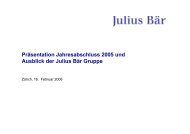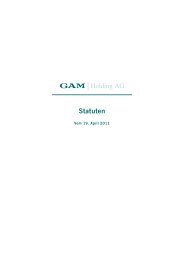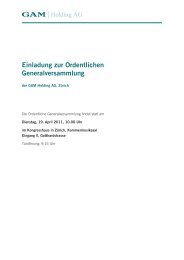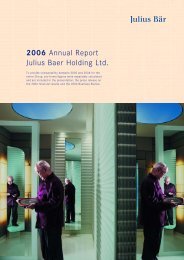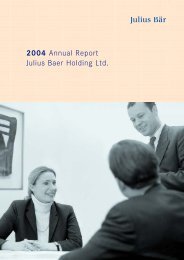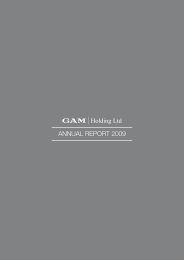2005 Annual Report Julius Baer Holding Ltd. - GAM Holding AG
2005 Annual Report Julius Baer Holding Ltd. - GAM Holding AG
2005 Annual Report Julius Baer Holding Ltd. - GAM Holding AG
Create successful ePaper yourself
Turn your PDF publications into a flip-book with our unique Google optimized e-Paper software.
Notes<br />
Comment on risk management<br />
1. Risk management framework and process<br />
Risk is defined as a deviation from an expected outcome.<br />
Risk management is a business enabler and<br />
therefore a key focus of the management process of<br />
the <strong>Julius</strong> <strong>Baer</strong> Group. The Group is exposed to various<br />
risks, resulting in the following risk landscape:<br />
– Strategic and business risks<br />
– Credit risks<br />
– Market risks (trading book)<br />
– Liquidity and financing risks<br />
(including market risk banking book)<br />
– Operational risks (including legal risks,<br />
compliance and personnel risks)<br />
– Reputational risks<br />
The Board of Directors defines and regularly reviews<br />
an appropriate risk policy to effectively manage<br />
the risks of the Group and to determine suitable<br />
processes and instruments. The Board of Directors<br />
is assisted by its Risk Committee.<br />
The overall responsibility for the implementation of<br />
the Group’s risk management lies with the Group<br />
Executive Board. It is assisted by its Risk Committee<br />
of the Executive Board (RCEB) and the following<br />
Group functions:<br />
– Group Risk Management (GRM) for the management<br />
and controlling of credit risks, market risks<br />
(trading book), liquidity and financing risks (especially<br />
banking book) and of operational risks<br />
(excluding legal risks and compliance)<br />
– Group Legal Management (GLM) for the management<br />
and controlling of legal risks and compliance<br />
These functions establish appropriate risk guidelines<br />
and directives, coordinate and contribute directly to<br />
the risk management of the divisions and ensure<br />
independent risk controlling. The main responsibility<br />
for risk management, however, lies with the divisions.<br />
82 JULIUS BAER GROUP<br />
All risks are mapped to a ‘risk landscape’ featuring<br />
the probability of occurrence and the potential<br />
impact and are managed by the divisions. The risk<br />
landscape is also used for the yearly strategic planning<br />
process by the divisions, the Group Executive<br />
Board and the Board of Directors.<br />
2. Strategic and business risks<br />
Strategic and business risks are managed and controlled<br />
by the divisions, the Group Executive Board<br />
and the Board of Directors. Following the principles<br />
of value- and risk-oriented management and controlling,<br />
an annual strategic check-up is carried out to<br />
determine the necessary strategic and structural<br />
projects and adjustments. After the analysis of the<br />
mid-term financial and risk-relevant implications,<br />
implementation is then initiated through a rolling 3year<br />
planning cycle, and then in the annual budgets<br />
accordingly.<br />
This process provides the basis for active and efficient<br />
financial, capital and risk management. The various<br />
controlling processes and tools – such as<br />
monthly comparison of the actual results with the<br />
budget or rolling forecasts – allow an analysis of the<br />
sensitivity of the Group’s earnings to various scenarios.





